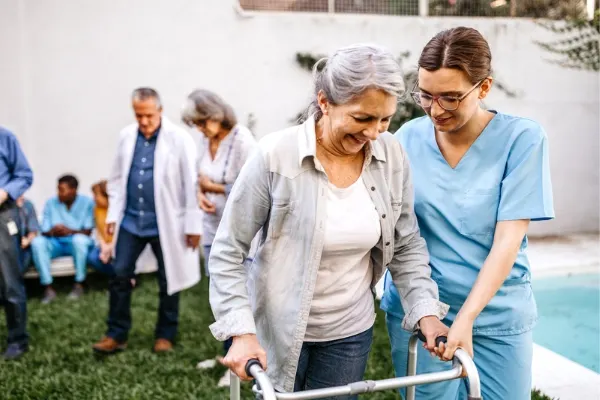The Florida Department of Health held Eudoniphyr Esmie, also known as Susie Esmie, accountable for failing to respond to a 90-year-old’s fall. A fine and probation were issued by the department against the Coral Springs ALF nurse.

This incident happened at Joan Lindsay’s Alternative Care an assisted living facility (ALF) for seniors.
At the start of their shift change, a staff member heard an alarming noise and discovered the resident face down on the floor around 7 am. The fall had caused bruises and damage to the right side of the resident’s head.
An investigation statement reveals that while the resident was conscious, they weren’t responding to verbal commands or physical stimulation. Reports further state that nursing assistance didn’t arrive until 7:50 am.

An administrative spokesperson declares that according to facility policy, in the event of an emergency such as this instance, it is protocol to assess the resident and directly contact 911.
Evidently, AHCA reports show that instead of dialing 911 right away, the nurse phoned an administrator and waited until they arrived on the premises. At that point, emergency service (EMS) was dialed.
As soon as EMS arrived, they initiated CPR due to critical vitals. The patient was then promptly transported to the ER at precisely 1:20 pm.
Post Event Ramification
According to a detective’s statement, they found the resident with a “considerable gash” on their forehead.
Esmie, ALF registered nurse, faces ramifications for not initiating proper protocol.
In the State of Florida’s Final Order, Esmie must pay a $1,000 fine and an additional $3,850 in investigative costs to the Department of Health. To ensure she abides by current standards, she must take 8-hour courses in critical thinking and patient assessment. Joan Lindsay’s Alternative Care was also fined $10,888.
Assisted Living Facilities And Nursing Homes: What’s The Difference?
Assisted living facilities and nursing homes are two of the most popular senior living options for elderly care. While both provide a safe and secure environment for seniors, there are some key differences between them.

Assisted living facilities offer more independence and freedom to seniors, while nursing homes provide more medical care and supervision.
Assisted living is often cheaper than nursing homes, making them a more affordable option for many families. Understanding the differences between assisted living facilities and nursing homes can help families make an informed decision about which type of senior care is appropriate.
Read Our Story On: Nurse Wins $1.2 Million For Reporting Nursing Home Fraud
Understanding Acuity In Assisted Living Facilities
According to AHCA’s inquiry, the 90-year-old resident was doing well until roughly four months before this unfortunate incident. As the decline progressed the resident became unable to do their regular daily activities. An administrator’s assistant confirmed this and added that more assistance was needed for this individual.

ALFs provide a unique level of care for their residents and aren’t usually adequately staffed for more involved care. Therefore, it is up to the facility to gauge when a transfer to a nursing home is needed.
What are Low-Acuity And High-Acuity?
Low-acuity patients are typically those with minor illnesses or injuries that don’t require complex care. That is to say, basic medical attention, over-the-counter medications, or home remedies can treat these conditions.
High-acuity patients necessitate comprehensive medical alerts and care. For instance, they may be suffering from critical illnesses or damages that demand specialized treatments and regular monitoring. Those with serious medical conditions often necessitate frequent appointments with the doctor or hospital for treatment and observation.
Studies Show Increased Population Of High-Acuity Patients In ALF
In 2021, Oxford University has released a study abstract regarding the trend of acuity in ALF. Assisted living facilities experienced an 18% increase in residents with high care needs, compared to 8.7% in nursing homes.

Assisted living residents who are dually eligible have demonstrated a higher level of acuity compared to those who aren’t. Policymakers and admins should soon evaluate assisted living capacity for the growing elderly population with complications.
The Challenges ALF Nurses Face
Assisted Living Facilities provide necessary assistance with daily activities to elderly and disabled people. Although, they are not able to provide the complex medical care necessary for high-acuity patients. Thus, it is important for those who need specialized medical care to find other solutions that can adequately meet their needs.

Additionally, Assisted Living Facilities may lack the staff training and experience to provide specialized care for patients. Like the accident mentioned at the very start, this will very much happen again if not taken seriously. Therefore, it is important to consider other options for high-acuity patients who require more extensive medical care.
Negligence in assisted living facilities can have fatal consequences; steps should be taken to guarantee that the facility is equipped to properly care for its residents. Facilities must ensure proper training, safety measures, and medical care for their staff.
Above all, it is essential to have all necessary supplies and equipment in good condition. By taking these steps, it is possible to reduce the risk of negligence in a high-acuity assisted living facility and provide quality care for its elderly residents.

How Can Assisted Living Facilities Prepare?
Facilities providing assisted living must be proactive in preparing for an influx of high-acuity patients. High-acuity patients require more specialized care than the average elderly patient. Consequently, it is essential that assisted living facilities have the necessary resources to provide this level of care.
When it comes to fall management, facilities must routinely remind staff of company policy. This includes developing strategies for staffing, training, and equipment needs. Running a few fall drills should be run in ALFs and nursing homes on a regular basis.

Final Words
Though we’re not sure about the level of acuity in this case, nurses are often faced with charges, regardless if the scenario is ideal or not. It’s important to turn down unsafe assignments to protect the patient and your license.
Document everything and keep a paper trail by email by your superior of these unsafe conditions. This particular event serves as a stark reminder to always remain vigilant as Esmie’s RN license was initially active in 1994 but due to this incident, it is now inactive as a result of disciplinary action.
See why Nurses Remain Among Most Trusted Profession For 22 Years